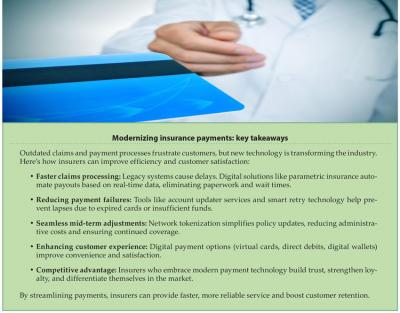The Green Sheet Online Edition
March 3, 2025 • 25:03:01
Transforming insurance payments with innovation, speed, better CX

For policyholders, one of the most frustrating aspects of insurance is the claims process. While awaiting reimbursement, customers often face lengthy waits—from several days to several months or longer, depending on the type of claim—extensive paperwork, and out-of-pocket expenses (see bit.ly/3ETZkJH).
This creates added stress, especially in urgent situations when they need funds quickly for essential repairs, replacements or medical bills.
Insurers may say that this is unavoidable, but customers aren’t likely to accept this as an answer during high-stress situations. Delayed payments create bad blood between customers and insurers that will inevitably lead to a percentage of customers going to different insurance providers, even if they have essentially the same policies.
These delays are often rooted in insurers’ legacy systems, which prioritize risk and fraud prevention over speed. While fraud prevention is essential, insurers need a balanced approach that also prioritizes customer needs.
Customers increasingly expect their insurers to provide timely, supportive service, without unnecessary delays. To remain competitive, insurers must update their claims processing and payment systems to better serve today’s customers.
The role of parametric insurance
If old technology is the problem, then it stands to reason that new technology will be the answer, and this appears to be the case. For example, parametric insurance is transforming claims processing by automating payments based on predetermined conditions, eliminating the need for customers to file a claim (see bit.ly/4izRDXR).
Unlike traditional insurance, where claims are initiated by the policyholder, parametric insurance relies on external data triggers. For example, a travel insurance policy could automatically issue a payout if a customer’s flight is delayed beyond a set time.
This data-driven, automated approach enhances customer experience by eliminating common friction points, particularly in urgent situations. It’s especially valuable in sectors where time-sensitive claims are common, such as travel, agriculture and property.
By using real-time data to trigger payments, insurers reduce administrative costs, improve efficiency and increase customer satisfaction. As more insurers adopt parametric models, customers will benefit from faster, hassle-free payouts.
Tackling recurring payment issues
Recurring payments are essential in insurance (as they are in many other industries), with most policies relying on monthly or annual premiums. However, issues such as expired cards, insufficient funds or bank changes frequently lead to payment failures. Missed payments can lead to coverage lapses, increased administrative costs and customer dissatisfaction.
To address these challenges, insurers are implementing tools like account updater services, which automatically refresh stored payment details when customers’ bank or card information changes. Smart retry technology, which times payment attempts for optimal success, also helps reduce failed transactions.
Fraud detection further improves security by monitoring transactions for irregularities, ensuring policies remain active and reducing the risk of failed payments.
Together, these solutions make recurring payments smoother and improve overall customer satisfaction and retention.
In today’s competitive market, customer loyalty is closely tied to the quality and efficiency of the claims process. A faster, more customer-friendly approach can transform what’s often viewed as an inconvenience into a positive experience. Insurers that prioritize speed, transparency and convenience not only increase customer satisfaction but also strengthen their reputation.
By offering digital payment options like virtual cards, direct debits and digital wallets, insurers can meet customers’ payment preferences and keep information up-to-date for seamless service. By removing friction from the claims process, insurers build trust and foster long-term relationships with their customers.
Streamlined claims processes also allow insurers to invest more in customer service and personalized engagement. This improved efficiency enables insurers to focus on meeting customer needs, ultimately driving loyalty.
Mid-term adjustments for the 21st century
Sometimes, insurance claims need to be adjusted to account for changes. This creates problems for payments: a payment needs to be cancelled, and a new recurring payment needs to be made.
If the new payment fails for any reason, then there are additional admin costs, and some customers may want to go elsewhere rather than deal with putting their payment through multiple times. All the while, the customer won’t have the coverage that they need until the payment is settled.
The same technology that facilitates recurring payments also makes changing them equally easy. Technology like network tokenization makes adjustments significantly easier by increasing the likelihood of new payments going through (see bit.ly/4bi3PtE).
By packaging the customer’s payment details in a way that card schemes will accept, we can make it far more likely for an individual payment to go through, whether it is a first payment, a recurring payment or a changed payment.
Embracing innovation for the future
The future of insurance payments is rooted in digital solutions that adapt to evolving customer expectations. Payment solutions today allow insurers to deliver a more efficient, transparent and customer-centric experience. By reducing delays, minimizing out-of-pocket expenses and simplifying the claims process, insurers can build trust and foster customer loyalty.
Insurers that embrace these innovations are well-positioned to stand out as customer-focused, forward-thinking brands. By investing in modern payment technology, insurers can shift from reactive claims processing to proactive, data-driven support.
This evolution has the potential to set a new standard for the industry, helping insurers deliver genuine value to customers when they need it most. 
Paul Clarke, chief growth officer at Cashflows, has a wealth of experience leading product, business strategy and innovation functions in the payments, ecommerce and digital sectors. He was previously executive vice president for product and innovation at international payments solutions provider Network International. He also held leadership positions at such key payment organizations as Barclaycard, Elavon and Worldpay. At fintech payments company Cashflows Paul is responsible for leading the product proposition, strategy and commercial go to market delivery functions of the business. Contact him via LinkedIn at www.linkedin.com/in/paul-clarke-890735. For more information about Cashflows, visit www.cashflows.com.
Whether you want to upgrade your POS offerings, find a payment gateway partner, bone up on fintech regs or PCI requirements, find an upcoming trade show, read about faster payments, or discover the latest innovations in merchant acquiring, The Green Sheet is the resource for you. Since 1983, we've helped empower and connect payments professionals, starting with the merchant level salespeople who bring tailored payment acceptance and digital commerce tools, along with a host of other business services to merchants across the globe. The Green Sheet Inc. is also a proud affiliate of Bankcard Life, a premier community that provides industry-leading training and resources for payment professionals.
Notice to readers: These are archived articles. Contact information, links and other details may be out of date. We regret any inconvenience.





